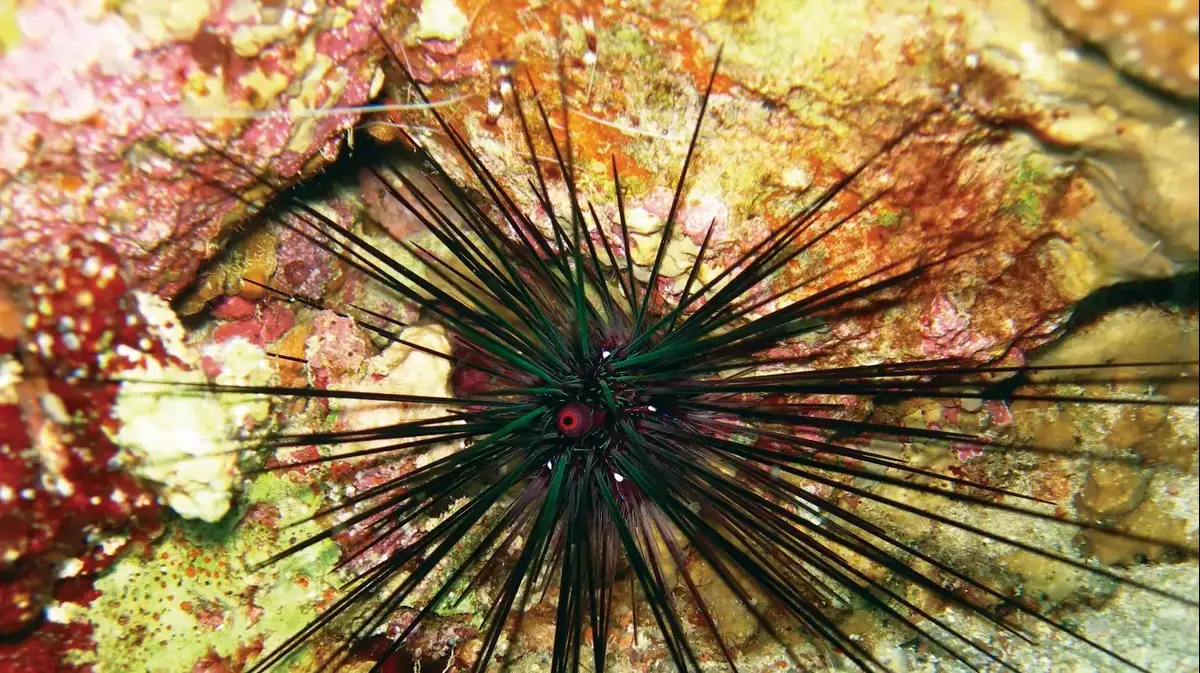A long-thorned monastic sea urchin in the Gulf of Aqaba (Photo: Haifa University Spokesperson's Office)
A series of alarming new studies by Tel Aviv University reveal a deadly trend that is causing mass mortality of black sea urchins in the Mediterranean Sea and the Gulf of Aqaba. According to studies, within a short period of time, the population of black sea urchins from Eilat was completely wiped out. For example, within a few months, thousands of sea urchins living at the site located on the northern shore of the Gulf of Aqaba died. The trend is so severe that today there is not a single living hedgehog at the site - only skeletons, and the same is true at other sites in the Gulf of Aqaba. Further research shows that widespread mortality also occurs in other countries in the region, including Jordan, Egypt, Saudi Arabia, Greece and Turkey.
The researchers emphasize that sea urchins in general, and especially the long-thorned monk, are considered key species essential for healthy coral reef function. The research team: "It must be understood that the level of threats to coral reefs is already at an all-time high, and now a new variable has been added that we do not know - there simply has not been such a situation in the documented history of the Gulf of Aqaba."
An uncertain pandemic wiped them out within months. The sea urchins are a long-thorned hernia (Photo: Haifa University Spokesperson's Office)
A hedgehog with long-thorned spikes in the Gulf of Aqaba (Photo: Haifa University Spokesperson's Office)
The hedgehog was also killed in the seas of Jordan and Sinai
The researchers believe that the source of the deadly epidemic is a single-celled pathogenic parasite from the cilia family, which moved from the Mediterranean Sea to the Red Sea. Following the study, an urgent report was submitted to the Nature and Parks Authority reviewing the current situation, and the emergency measures to be taken to save Israel's coral reef are currently being considered.
The study was led by Dr. Omri Bronstein and doctoral students Rotem Ziller, Lisa Maria-Schmidt, Chen Roth, and Gal Eviatar from Tel Aviv University's Steinhardt School of Zoology and Natural History Museum. The studies have been published in Frontiers in Marine Science and Royal Society Open Science.
Dr. Bronstein emphasizes: "Due to the intensity of mortality, we initially thought it was pollution, a local chemical spill, or poisoning from industry and hotels in the northern Gulf, but after examining other sites in Eilat, Jordan and Sinai, we realized that this was not a local event. All signs point to a rapidly spreading epidemic. Similar reports come from colleagues in Saudi Arabia. Even hedgehogs that we raised in aquariums for research purposes at the Inter-University Institute, and sea urchins at the Underwater Observatory in Eilat, became infected and died, probably because the pathogen managed to enter through the pumping systems. It's a quick and violent death: within two days a healthy hedgehog turns into a tissueless skeleton. While some of the carcasses wash ashore, most hedgehogs are eaten while dying and unable to defend themselves, which can accelerate infection by the fish that prey on them."
Dr. Bronstein adds: "My group has been researching marine invasions in recent years, and among other things we focus on a species of sea urchin called Diadema setosum. Until recently, it was one of the most common species on the Eilat coral reef - these are the black hedgehogs with long thorns that we all know. Sea urchins in general, and especially the long-thorned monk, are considered key species essential for the healthy functioning of the coral reef. Hedgehogs are the 'gardeners' of the reef – they feed on the algae and prevent them from taking over and suffocating the corals that compete with them for sunlight. Unfortunately, these hedgehogs no longer exist in the Gulf of Aqaba, and further south in ever-expanding parts of the Red Sea."
Within months, all the hedgehogs in the Gulf of Aqaba were eliminated (Photo: Haifa University Spokesperson's Office)
Populations in the Mediterranean remain small and mostly hidden
The first reports of mass deaths reached Dr. Bronstein a few months ago from his colleagues in Greece and Turkey, where the hedgehogs invaded, probably through the Suez Canal.
"In 2006, the first hedgehog of this species was found in the Mediterranean Sea in southern Turkey. This is a phenomenon that we know as a biological invasion, with widespread ecological consequences, that is very common in the eastern Mediterranean and especially along Israel's coastline," adds Dr. Bronstein. "Since then we have been following the dynamics of the sex invasion in the Mediterranean. In 2016, we discovered the first hedgehog on Israel's shores - a single specimen at Gordon Beach in Tel Aviv. For more than a decade since the first discovery in Turkey, populations in the Mediterranean Sea have remained small and mostly hidden, but starting in 2018, hedgehogs in the Mediterranean Sea have reached a state of exponential growth or population explosion – and huge populations of thousands and tens of thousands of individuals have been observed in Greece and Turkey. But while we were working on a study summarizing the hedgehog invasion in the Mediterranean, we were starting to get reports of sudden and widespread mortality. Ostensibly, there is nothing wrong with the extinction of an invasive species in the Mediterranean, but two important points must be remembered: First, we do not yet know how mortality and its causes will affect native species in the Mediterranean. Second, and even worse, the geographical proximity between the eastern Mediterranean and the Red Sea may allow rapid passage of the pathogen to the natural population of the Red Sea – which unfortunately happened."
The mass mortality reminded researchers at Tel Aviv University of one of the most well-known and serious stories in the history of marine ecology: the story of the disappearance of sea urchins from the Caribbean. Until 1983, the Caribbean coral reef was a thriving tropical reef that largely resembled the coral reef in the Gulf of Aqaba. But then a mysterious disease wiped out most of the population of sea urchins of the species Diadema antillarum - relatives of the hedgehogs from Eilat. When the hedgehogs disappeared, the algae multiplied uncontrollably, obscuring sunlight from the corals, and the entire reef underwent an irreversible transformation - from a coral reef to algae fields.
"Last year, the disease resurfaced in the Caribbean, killing the populations and individuals that survived," says Dr. Bronstein. "Unlike past events, today we have the scientific and technological tools to decipher the forensic evidence. Last month, a group of researchers from Cornell University identified the killer in the Caribbean: a pathogenic parasite in the cilia family. The pathology we see in sea urchins that die in Greece and Turkey is the same as the pathology of hedgehogs in the Caribbean, and this is also the pathology of the hedgehogs that die here in the Red Sea."
Marine researchers at the University of Haifa (Photo: Haifa University Spokesperson's Office)
There is still a big unknown: what kills the hedgehogs?
Dr. Bronstein's study is the first to point to mass mortality of an invasive species in the Mediterranean, and the first to point to mass mortality among sea urchins of the species Diadema setosum - one of the most common sea urchin species in the world. Dr. Bronstein concluded his groundbreaking research with a warning that the epidemic currently breaking out in the Mediterranean Sea may also spread to the nearby Red Sea, a warning that has come true. "You have to understand the gravity of the situation: mortality in the Red Sea is advancing at a dizzying speed, and the affected areas already encompass a much wider area than we know in the Mediterranean. In the background there is still a big unknown: what kills the hedgehogs? Is it a Caribbean pathogen or a new and unknown factor? Either way, it is clear to us that the pathogen is carried in water, and we expect that within a short time all populations of these hedgehogs, both in the Mediterranean and Red Seas, will get sick and die.
"In my opinion, we need to establish a breeding nucleus of these sea urchins today, so that we can return them to the wild in the future, if necessary. As with the coronavirus, no one knows at this stage what will happen – whether this pandemic will go away on its own or whether it will remain here for many more years and lead to a dramatic change in the coral reef. However, unlike the coronavirus, we do not have the option to vaccinate the hedgehogs or treat them, so we must invest all our efforts in prevention. Unfortunately, the window of opportunity to preserve a healthy population of this species in Eilat has already closed. If we want to establish a breeding nucleus, we must act today and preserve healthy individuals from the Israeli Mediterranean Sea – before the disease that progresses from the north reaches that too. This is a complex task, since the pathogen is carried in the water and we will have to establish a habitat system that is completely detached from the sea, but it is a necessary step if we are to ensure the survival of this unique and critical species for the future of the coral reef."
- tourism
- news
Tags
- Hedgehogs
- animal
- Gulf of Aqaba
- Red Sea








